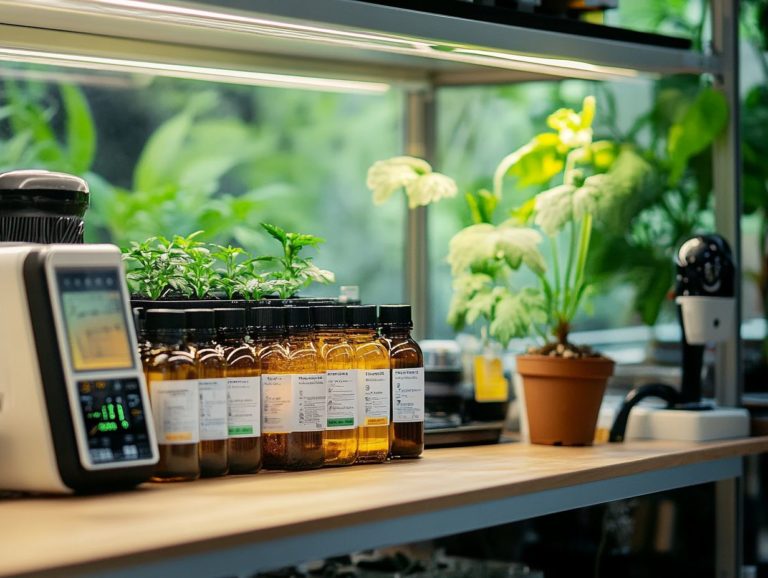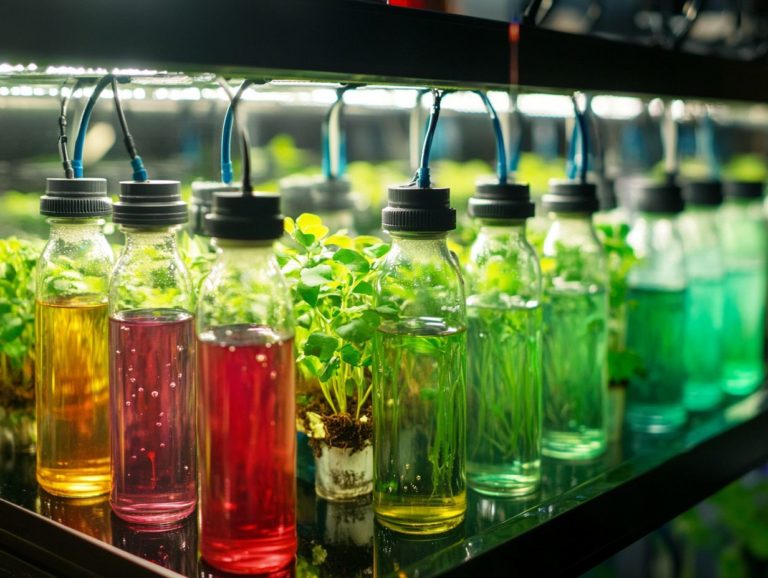Hydroponic Nutrient Cycling: What to Know
Hydroponic systems have revolutionized plant cultivation. You can now grow without the constraints of soil.
At the core of this innovative method is nutrient cycling. This crucial process ensures your plants receive the essential nutrients for optimal growth.
Get ready to explore nutrient cycling and how it can transform your hydroponic success! Discover its benefits, the types of systems available, and practical steps for implementation.
It also highlights common pitfalls to avoid. This way, you can maximize your hydroponic success!
Contents
- Key Takeaways:
- Understanding Hydroponic Nutrient Cycling
- Benefits of Nutrient Cycling in Hydroponics
- Types of Nutrient Cycling Systems
- How to Implement Nutrient Cycling in Hydroponics
- Common Mistakes to Avoid
- Frequently Asked Questions
- What is hydroponic nutrient cycling?
- Why is nutrient cycling important in hydroponics?
- What are the main nutrients involved in hydroponic nutrient cycling?
- How can I ensure proper nutrient cycling in my hydroponic system?
- What techniques can I use for nutrient cycling in hydroponics?
- Can nutrient cycling in hydroponics be automated?
Key Takeaways:

- Nutrient cycling reuses water and nutrients in a hydroponic system, leading to healthier plants and less waste.
- Implementing nutrient cycling can optimize plant growth, with continuous flow systems being the most effective.
- Focus on key components and techniques to successfully implement nutrient cycling, and avoid common mistakes with regular maintenance.
Understanding Hydroponic Nutrient Cycling
Understanding hydroponic nutrient cycling is essential for achieving optimal growth. This process involves the movement and transformation of nutrients in a carefully controlled environment.
Hydroponic gardening relies on a balance of macronutrients and micronutrients. These are delivered through a nutrient solution that can be adjusted for different growth stages.
By mastering nutrient cycling, you can address issues like nutrient deficiencies and boost chlorophyll production. This leads to healthier and more vibrant plants.
What is Nutrient Cycling?
Nutrient cycling is the constant movement of nutrients in hydroponic systems. This creates an ideal environment for plant growth.
This process ensures essential elements are always available, promoting robust development. Key nutrients like nitrogen, phosphorus, and potassium play vital roles in plant health.
Nitrogen supports leaf growth, phosphorus fuels root development, and potassium boosts overall vitality. Micronutrients such as calcium and magnesium strengthen cell structure.
In a hydroponic setup, these nutrients work together efficiently. This careful balance leads to thriving plants and great results.
Benefits of Nutrient Cycling in Hydroponics
The benefits of nutrient cycling in hydroponics are significant. It plays a vital role in enhancing plant growth and health in a controlled setup.
By adopting effective nutrient cycling practices, your plants will receive a well-balanced nutrient solution. This approach reduces the risk of deficiencies and promotes a healthy growth cycle.
Optimizing Plant Growth and Health

Optimizing plant growth in hydroponics requires understanding how plants absorb nutrients and addressing any deficiencies quickly.
To cultivate thriving plants, adjust nutrient ratios and monitor pH levels meticulously. Each plant species has its own nutritional needs, and fine-tuning these ratios ensures essential elements are available.
Maintaining proper pH levels is critical as it directly affects nutrient availability. Aim for a range of 5.5 to 6.5 for many hydroponic systems.
Choosing the right growing medium is also crucial. It influences water retention and aeration, both vital for strong root development.
These strategies enhance chlorophyll production, leading to robust foliage and overall plant vitality. Healthier plants can harness light more effectively for photosynthesis.
Types of Nutrient Cycling Systems
In hydroponics, various nutrient cycling systems meet diverse growing needs. They are mainly categorized as continuous flow and batch systems.
Continuous flow systems deliver a steady stream of nutrient solution through the growing medium. This ensures constant nutrient availability.
Batch systems provide nutrient solutions at set intervals. This creates a controlled environment that you can adjust based on plant growth stages or conditions.
Continuous Flow vs. Batch Systems
Continuous flow and batch systems offer two distinct approaches to nutrient cycling in hydroponics. Each has its operational mechanics and implications for plant growth.
Both systems aim to optimize nutrient delivery, but they differ in maintaining and distributing these essential elements. Continuous flow systems, like the nutrient film technique (NFT), circulate a thin film of nutrient-rich water, allowing roots to absorb nutrients efficiently.
Batch systems, like deep water culture (DWC), use larger reservoirs where plants are immersed in nutrient-rich solutions that require periodic replacement. This affects maintenance; continuous flow setups need careful monitoring to prevent blockages.
Continuous flow systems provide a steady nutrient supply, promoting rapid growth. Batch systems offer a controlled nutrient delivery environment, which is beneficial for specific crops.
Ultimately, each method has advantages and disadvantages, so choose based on your unique agricultural needs and conditions.
How to Implement Nutrient Cycling in Hydroponics
Implementing nutrient cycling in hydroponics requires a systematic approach. This integrates essential components and techniques to optimize plant growth.
Start by selecting the right hydroponic systems designed for efficient nutrient cycling. Next, formulate nutrient solutions tailored to your plants’ unique needs.
Understanding the elements that affect nutrient cycling helps maintain balanced pH levels and nutrient ratios. This proactive strategy minimizes the risk of deficiencies, encouraging robust plant health.
Key Components and Techniques

Key components and techniques for effective nutrient cycling in your hydroponic system include meticulously formulated nutrient solutions, precise pH adjustment, and efficient irrigation systems.
These factors are essential for optimizing plant growth and maximizing yield. Your nutrient solutions should be carefully balanced to deliver the essential nutrients, ensuring that your plants efficiently absorb what they require. Maintaining an appropriate pH level, typically between 5.5 and 6.5, is equally important; even a minor deviation can lead to deficiencies or toxicities that hinder growth.
By employing advanced irrigation techniques, such as drip or aeroponic systems, you can ensure uniform moisture and nutrient distribution, which enhances root health and nutrient uptake.
Together, these components create a thriving hydroponic ecosystem, allowing your plants to flourish sustainably and reach their full potential.
Make sure to adjust nutrient ratios based on the growth stage, as young plants need different nutrients!
Common Mistakes to Avoid
In your pursuit of successful hydroponic gardening, it’s crucial to steer clear of common mistakes in nutrient cycling that can profoundly affect plant health and yield.
Errors such as incorrect nutrient ratios and improper pH levels can result in nutrient deficiencies, ultimately stunting optimal growth. By identifying and addressing these pitfalls, you can adopt more effective nutrient cycling practices, paving the way for improved results in your hydroponic systems.
Troubleshooting and Maintenance Tips
Troubleshooting and maintenance tips are critical for ensuring a successful nutrient cycling process in your hydroponics system. By staying proactive, you can prevent nutrient deficiencies and promote robust plant growth.
These measures protect the health of your plants and enhance the efficiency of your entire growth system. Regular monitoring is essential; check nutrient solutions regularly to catch potential pH imbalances that could lead to nutrient lockout. For a deeper insight into this aspect, refer to our guide on understanding hydroponic system cycles. Adjusting nutrient ratios according to the different stages of plant growth is crucial, as young plants typically require different nutrient concentrations than their mature counterparts.
Keeping a close watch on your plants’ responses offers valuable insights; yellowing leaves or stunted growth can signal that it s time to make adjustments. By adhering to these practices, you can significantly boost your chances of achieving optimal results in your hydroponic setup, enhancing chlorophyll production and preventing potential nutrient deficiencies.
Frequently Asked Questions
What is hydroponic nutrient cycling?

Hydroponic nutrient cycling is the process of replenishing and recycling essential nutrients in a hydroponic system to ensure healthy plant growth.
Why is nutrient cycling important in hydroponics?
Nutrient cycling is important in hydroponics because it helps maintain a balanced and sustainable nutrient supply for plants, leading to better yields and healthier plants.
What are the main nutrients involved in hydroponic nutrient cycling?
The main nutrients involved in hydroponic nutrient cycling are nitrogen, phosphorus, and potassium, also known as NPK. These are essential for plant growth and development, along with other macronutrients and micronutrients such as calcium, magnesium, sulfur, iron, zinc, copper, boron, and molybdenum. Effective nutrient uptake is vital in hydroponic systems to ensure plants receive these nutrients efficiently.
How can I ensure proper nutrient cycling in my hydroponic system?
To ensure proper nutrient cycling, monitor and adjust the nutrient levels in your hydroponic systems regularly. This includes checking pH levels and keeping your system clean.
What techniques can I use for nutrient cycling in hydroponics?
There are effective techniques for nutrient cycling in hydroponics. You can use compost teas, beneficial microorganisms, and crop rotation to improve your system.
Can nutrient cycling in hydroponics be automated?
Yes, you can automate nutrient cycling using specialized equipment. Tools like nutrient dosers and recirculating systems help manage this process efficiently.






